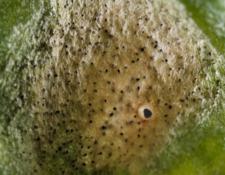当前位置:
X-MOL 学术
›
Plant Pathol.
›
论文详情
Our official English website, www.x-mol.net, welcomes your feedback! (Note: you will need to create a separate account there.)
Impact of Brassica napus–Leptosphaeria maculans interaction on the emergence of virulent isolates of L. maculans, causal agent of blackleg disease in canola
Plant Pathology ( IF 2.7 ) Pub Date : 2020-10-12 , DOI: 10.1111/ppa.13293 M. Harunur Rashid 1 , Sakaria Liban 1 , Xuehua Zhang 1 , Paula Parks 1 , Hossein Borhan 2 , W. G. Dilantha Fernando 1
Plant Pathology ( IF 2.7 ) Pub Date : 2020-10-12 , DOI: 10.1111/ppa.13293 M. Harunur Rashid 1 , Sakaria Liban 1 , Xuehua Zhang 1 , Paula Parks 1 , Hossein Borhan 2 , W. G. Dilantha Fernando 1
Affiliation

|
Canola (Brassica napus) is the major oilseed crop in Canada. Blackleg (Leptosphaeria maculans) causes yield losses annually, with a larger impact in the last two decades caused by breakdown of resistance in growers’ fields. A 4‐year small‐plot field study from 2014 to 2017 in Manitoba investigated the impact of the B. napus–L. maculans interaction on the emergence of virulent isolates towards specific R genes. Doubled haploid B. napus ‘Topas’ introgression lines carrying single R genes were used, with a 2‐year canola–wheat rotation. Blackleg incidence was reduced by 40% in 2017 compared to 2014 for all R genes tested except Rlm4. In 2017, disease severity was reduced between 21% and 52% compared to 2014 for all R genes tested except Rlm2. There was a significant shift from AvrLm2 and AvrLm4 to virulent alleles avrLm2 and avrLm4, respectively, which led to the gain of virulence toward Rlm2 and Rlm4 Topas introgression lines within a year. Sequencing of the AvrLm2 gene of isolates from 2014 and 2015 revealed a shift of AvrLm2 to avrLm2 allele due to accumulation of point mutations. Masking of AvrLm3 phenotype by the presence of the AvrLm4‐7 allele was also confirmed by analysing phenotypes and genotypes of the isolates collected from 2014 to 2017. Based on these and previous findings, we demonstrate the need for an epidemiological model that takes into account complex molecular mechanisms allowing plant breeders to select appropriate R genes, including balanced cultivar rotation strategies to maintain blackleg resistance in the Canadian Prairies.
中文翻译:

甘蓝型油菜-Leptosphaeria maculans相互作用对油菜黑腿病病原体-Maculans毒力分离株的出现的影响
双低油菜籽(芸苔)是加拿大的主要油料作物。Blackleg(Leptosphaeria maculans)每年造成单产损失,在过去的二十年中,由于种植者田间抗药性下降而造成的影响更大。2014年至2017年在曼尼托巴进行的为期4年的小规模田间研究调查了B的影响。napus–L。maculans上强毒分离株朝向特定的出现相互作用- [R基因。加倍单倍体乙。使用带有单个R基因的甘蓝型油菜“ Topas”基因渗入系,并进行了两年的油菜-小麦轮作。与2014年相比,2017年黑腿病发病率降低了40%除Rlm4外,测试了R基因。与2014年相比,除Rlm2外的所有R基因测试的疾病严重程度与2014年相比,降低了21%至52%。从AvrLm2和AvrLm4分别转移到有毒等位基因avrLm2和avrLm4,这导致一年内对Rlm2和Rlm4 Topas渗入系的毒力增加。2014年和2015年分离株的AvrLm2基因测序显示,由于点突变的积累,AvrLm2向avrLm2等位基因转移。掩盖AvrLm3通过分析2014年至2017年收集的分离株的表型和基因型,也证实了存在AvrLm4-7等位基因的表型。基于这些和以前的发现,我们证明了需要考虑复杂分子机制的流行病学模型植物育种者选择合适的R基因,包括平衡的品种轮换策略,以维持加拿大大草原的黑脚resistance抗性。
更新日期:2020-10-12
中文翻译:

甘蓝型油菜-Leptosphaeria maculans相互作用对油菜黑腿病病原体-Maculans毒力分离株的出现的影响
双低油菜籽(芸苔)是加拿大的主要油料作物。Blackleg(Leptosphaeria maculans)每年造成单产损失,在过去的二十年中,由于种植者田间抗药性下降而造成的影响更大。2014年至2017年在曼尼托巴进行的为期4年的小规模田间研究调查了B的影响。napus–L。maculans上强毒分离株朝向特定的出现相互作用- [R基因。加倍单倍体乙。使用带有单个R基因的甘蓝型油菜“ Topas”基因渗入系,并进行了两年的油菜-小麦轮作。与2014年相比,2017年黑腿病发病率降低了40%除Rlm4外,测试了R基因。与2014年相比,除Rlm2外的所有R基因测试的疾病严重程度与2014年相比,降低了21%至52%。从AvrLm2和AvrLm4分别转移到有毒等位基因avrLm2和avrLm4,这导致一年内对Rlm2和Rlm4 Topas渗入系的毒力增加。2014年和2015年分离株的AvrLm2基因测序显示,由于点突变的积累,AvrLm2向avrLm2等位基因转移。掩盖AvrLm3通过分析2014年至2017年收集的分离株的表型和基因型,也证实了存在AvrLm4-7等位基因的表型。基于这些和以前的发现,我们证明了需要考虑复杂分子机制的流行病学模型植物育种者选择合适的R基因,包括平衡的品种轮换策略,以维持加拿大大草原的黑脚resistance抗性。



























 京公网安备 11010802027423号
京公网安备 11010802027423号